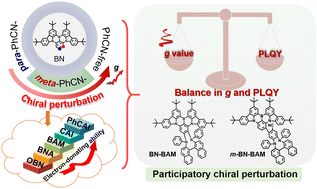Design of high-performance circularly polarized multiple resonance-based TADF materials via participatory chiral perturbation†
Abstract
Multiple-resonance thermally activated delayed fluorescence (MR-TADF) materials have attracted tremendous attention recently, but it remains a formidable challenge to design circularly polarized MR-TADF (CP-MR-TADF) emitters concurrently exhibiting high quantum efficiency, narrowband emission and high dissymmetry factor. Here, we perform a systematic theoretical investigation on the design of high-performance CP-MR-TADF materials via participatory chiral perturbation by regulating the introduction modes of peripheral groups and types of electron-donating chiral perturbation units capable of directly participating in the TADF emission. The designed molecules maintain the multiple-resonance characteristics with narrowband emissions after the introduction of chiral units. And, the meta-PhCN-based and PhCN-free molecules with the moderate electron-donating chiral unit of BAM exhibit excellent performance in light of the narrowband emissions, large dissymmetry factors, facile reverse intersystem crossing channels with large spin–orbit coupling values and efficient fluorescence radiative rates. It was found that the small centroid distance between the chiral unit and the multiple-resonance B/N skeleton, and the obvious chiral unit participation in the frontier molecular orbital distributions should be two key factors in realizing a large degree of chiral perturbation of the circularly polarized luminescent (CPL) signals of materials. These findings and insights are important as they reveal the structure–property relationship of CP-MR-TADF materials constructed using a chiral perturbation strategy, providing an in-depth understanding of the design of such high-performance materials.

- This article is part of the themed collection: Circularly Polarised Luminescence


 Please wait while we load your content...
Please wait while we load your content...